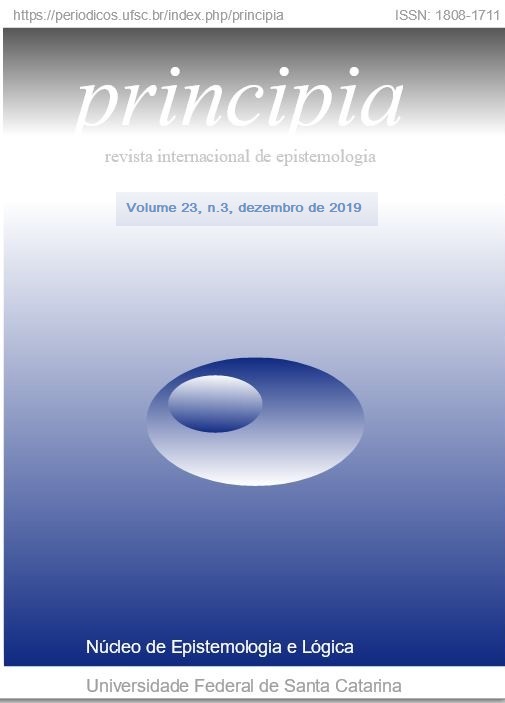The Contingency of Physical Laws
DOI:
https://doi.org/10.5007/1808-1711.2019v23n3p487Abstract
The purpose of this paper is to explain the sense in which laws of physics are contingent. It argues, first, that contemporary Humean accounts cannot adequately explain the contingency of physical laws; and second, that Hume’s own arguments against the metaphysical necessity of causal connections are not applicable in this context. The paper concludes by arguing that contingency is an essentially emergent, macroscopic phenomenon: we can understand the contingency of fundamental physical laws only through their relation to the distribution of macroscopic modal properties in the manifest world.References
Armstrong, D. 1983. What is a Law of Nature? Cambridge: Cambridge University Press.
Ayer, A, J. 1956. What is a Law of Nature? Revue Internationale de Philosophie 10 (36): 2-36.
Bird, A. 2007. Nature’s Metaphysics: Laws and Properties. Oxford: Oxford University Press.
Cassirer, E. 1910. Substanzbegriff und Funktionsbegriff. Untersuchungen über die Grundfragen der Erkenntniskritik. Berlin: Bruno Cassirer.
Demarest, H. 2017. Powerful Properties, Powerless Laws. In: J. D. Jacobs (ed.), Causal Powers, p.38–54. Oxford: Oxford University Press.
Descartes, R. 1985. The World or Treatise on Light. In: Philosophical Writings of Descartes, Volume 3. Trans. John Cottingham, Robert Stoothoff, Dugald Murdoch, and Anthony Kenny. Cambridge: Cambridge University Press.
Ellis, B. 2001. Scientific Essentialism. Cambridge: Cambridge University Press.
Feynman, R. 1965. The Character of Physical Laws. London: Modern Library.
Freddoso, Alfred, 1988. Medieval Aristotelianism and the Case against Secondary Causation in Nature. In: Morris, T. V. (ed.), Divine and Human Action: Essays in the Metaphysics of Theism, p.74–118. Ithaca: Cornell University Press.
Goodman, N.1955. Fact, Fiction, and Forecast. Cambridge MI: Harvard University Press.
Heil, J. 2017. Real Modalities. In: J. D. Jacobs (ed.), Causal Powers, p.77 – 89. Oxford: Oxford University Press, 77-89.
Hempel, C., 1965. Aspects of Scientific Explanation and Other Essays in the Philosophy of Science. New York: Free Press.
Hume, D. 1975(T). A Treatise of Human Nature. L. A. Selby-Bigge (2nd ed.) revised by P. H. Nidditch. Oxford: Clarendon Press.
Hume, D. 1975(E). Enquiries concerning Human Understanding and concerning the Principles of Morals. L. A. Selby-Bigge (3rd ed.) revised by P. H. Nidditch. Oxford: Clarendon Press.
Kail, P. J. E. 2008. Hume’s appropriation of Malebranche: Causation and self. European Journal of Philosophy 16(1): 55—80.
Kneale, W. 1949. Probability and Induction. Oxford: Clarendon Press.
Kripke, S., 1972. Naming and Necessity. Cambridge: Harvard University Press.
Lewis, D., 1986a. On the Plurality of Worlds. Oxford: Basil Blackwell.
Lewis, D. 1986b. Philosophical Papers, Volume II. New York: Oxford University Press.
Lewis, D. 1999. Paper in Metaphysics and Epistemology. Oxford: Oxford University Press.
Lewis, D. 2009, Ramseyan Humility. In: D. B. Mitchell & R. Nola (ed.), Conceptual Analysis and Philosophical Naturalism, p.203–222. Cambridge, Mass.: MIT Press.
Loewer, B. 1996. Humean Supervenience. Philosophical Topics 24(1): 101–126.
Loewer, B. 2007. Laws and Natural Properties. Philosophical Topics 35(1/2): 313–328.
Loewer, B. 2011. The emergence of time’s arrows and special science laws from physics. Interface Focus, doi:10.1098/rsfs.2011.0072.
Mackie, J. 1977. Dispositions, Grounds and Causes. Synthese 34(4): 361–370.
Mumford, S. 2004. Laws in Nature. London: Routledge.
Nagel, E. 1961. The Structure of Science. London: Routledge and Kegan Paul.
Prior, E.; Pargetter, R.; & Jackson, F. 1982. Three Theses about Dispositions. American Philosophical Quarterly 19(3): 251–257.
Sellars, W. 1948. Concepts as Involving Laws and Inconceivable without Them. Philosophy of Science 15(4): 287–315.
Sellars, W. 1963. Philosophy and the Scientific Image of Man. In: Science, Perception and Reality, p.1–40. London: Routledge and Kegan Paul.
Shoemaker, S., 1980. Causality and Properties. In: P. van Inwagen, (ed.), Time and Cause, p.109–135. Dordrecht: D. Reidel Publishing Company.
Shoemaker, S. 1998. Causal and Metaphysical Necessity. Pacific Philosophical Quarterly 79(1): 59–77.
Sidelle, A. 2002. On the Metaphysical Contingency of Laws of Nature. In: T. Szabó Gendler and J. Hawthorne (ed.), Conceivability and Possibility, p.309–336. Oxford: Clarendon Press.
Swoyer, C., 1982. The Nature of Natural Laws. Australasian Journal of Philosophy 60(3): 203–223.
Van Fraassen, B. 1987. Laws and Symmetry. Oxford: Clarendon Press.
Downloads
Published
Issue
Section
License

Principia http://www.periodicos.ufsc.br/index.php/principia/index is licenced under a Creative Commons - Atribuição-Uso Não-Comercial-Não a obras derivadas 3.0 Unported.
Base available in www.periodicos.ufsc.br.



